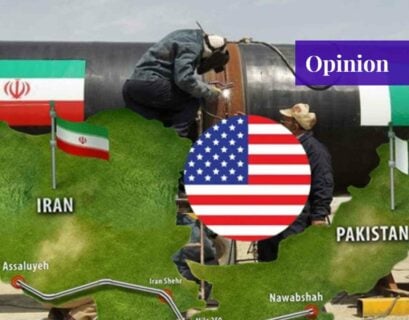Abstract
Crises don’t rise out of the blue; they are the result of ongoing circumstances and are consequences of the actions of a single individual that starts the chain reaction of complicated existence. Even World War I was sparked by the actions of a single individual (Khan, 2021). The water crisis around the world, specifically in Pakistan, is of grave concern.
“Anyone who can solve the problem of water, will be worthy of two noble prizes: one for peace and one for science” – John F. Kennedy
Water is a finite resource. If it’s not managed wisely, overcoming climate issues is a great challenge. The paper analyses how the water issue is more of a management crisis than a natural disaster in Pakistan. Moreover, this paper also analyzes the case of the Tasman Spirit oil spill for a holistic analysis of mismanagement and crippled governance
Methodology
The paper is based upon qualitative research focusing on “how” the water issue prevails and “what” caused the water issue. The qualitative data is obtained from sources like articles, journals, reports, books, official and unofficial documents, and academic studies.
Water Issue
Water’s central role in the biosphere implies that several of the large issues confronting humanity are in fact related to water be it security issues, pollution, shortage, etc. (Falkenmark, 1990). Whenever the issue of water is being talked about the terms that are widely used in the international discourse are water shortage, water stress, water scarcity, and water insecurity (Chellaney, 2012).
The issue of water revolves around crisis, scarcity, insecurity, and shortage. These terms will be used often in this research paper with the purpose of analyzing and understanding the water issue prevailing in Pakistan. Water shortage is the condition when there is a lack of sufficient water resources. This includes a lack of access to safe water supplies and deprivation to meet basic water needs.
According to UN-Water, water scarcity is defined as scarcity in the availability of water due to physical shortage or access due to failure in management and governance (Water Scarcity, n.d.). When the demand for water exceeds the amount available during a specific period of time, such a situation is known to be water-stressed (Green Facts, n.d.). Lastly, water insecurity, as defined by Norins, is the lack of sufficient water to meet all the needs and the inability to adapt to disasters (Defining Water Insecurity, n.d.).
Introduction
The continent of Asia is the hub of the water crisis where water emerges as a source of increasing competition and an underlying discord between the Asian states (Chellaney, 2012). India and Pakistan are prime examples of such discord. Asia faces a daunting challenge in the form of the water crisis that threatens its economy, political rise, and most importantly its environmental sustainability (Chellaney, 2012).
Due to Asia’s water efficiency and productivity being the lowest in the world, it is a center of global water issues, be it crises or security issues. A South Asian country like Pakistan, which has been struggling in almost every aspect ever since independence, is no exception. Pakistan is amongst those countries of Asia that are on the hitlist of water issues be it in terms of a crisis, security, scarcity, or even shortage.
Scope of Water Issue in Pakistan
Firstly, about 92% of Pakistan has been classified into semi-arid to arid. Moreover, the vast majority of Pakistan is dependent upon surface and groundwater from a single source known as the Indus Basin. Secondly, ever since Pakistan came into existence, its population has more than quadrupled and by 2100, its population will have increased by tenfold.
Thirdly, about 90% of the country’s agriculture production comes from land irrigation by the Indus Basin Irrigation System (IBIS) which firmly links national food security to water levels in the Indus River. Fourthly and lastly, Pakistan’s water storage capacity is limited to a maximum of 30 days supply which is far below a 1000 days storage capacity (Parry, Terton, Osman, Ledwell, and Asad, 2016)
Water Issues of Pakistan
The water issue poses a great threat to the country’s future security, sustainability, and stability. In 2030, according to the Food and Agricultural Organization, Pakistan is expected to move from being a water-stressed to a water-scarce country (Omestad, 2013).
The Pakistan Council of Research in Water Resources (PCRWR) delivered a grave warning that if the government didn’t take action, the country will run out of water by 2025 (Kundi, 2017). IMF ranked Pakistan 3rd on the list of water-scarce countries (Zhang, et al., 2020). Pakistan is hence regarded as one of the most water-intensive countries (Akbar, Khan, Dilawar, & Hassan, 2021).
One of the deadliest issues that Pakistan faces is water security, particularly due to political disputes and upheavals. The security concerns related to Pakistan are primarily Islamist militancy and terrorism, stability in regard to Afghanistan, and nuclear rivalry with India. While all the concerns are driven towards these issues, the country’s deteriorating water situation naturally becomes a lesser-known issue. Despite being a comparatively lesser-known issue, the intensity and situation are highly alarming.
According to the Peacework report titled “Understanding Pakistan’s Water-Security Nexus,” authored by Danish Mustafa, Majeed Akhtar, and Natalie Nasrallah, “Coupled with institutional, operational, and governance failures, increasing pressure on water, its use, and misuse is fostering domestic discord. Although water is not a direct driver of conflict, it is an aggravating factor that threatens various dimensions of Pakistan’s political fragility” (Mustafa, Akhter, & Nasralla, 2013).
The construction of dams on the Indus River and the depletion of groundwater in Balochistan are exacerbating tensions and hurting small farms in provinces that are wracked by extremist violence and the Pakistan Army’s counterinsurgency operations (Omestad, 2013).
Indicators of Water Scarcity
Despite being a country with the world’s largest glaciers, Pakistan faces the prospects of water scarcity (“Issues in Managing Water Challenges,” 2015). When we talk about scarcity, there are four main indicators to measure water scarcity:
1. Water Stress Indicator
The first indicator provides the relationship between available water and human pollution. As per the indicator, if a country’s per capita water is below 1700m3, it is water-stressed. When per capita water is below 500m3, the country is in absolute water scarcity. In 1950, the per capita water was over 5000m3 in Pakistan. In 1990, Pakistan touched the water stress line (Ashraf, 2018).
2. Water Resource Vulnerability Index (WRVI)
This indicator compares national annual water availability with the total annual withdrawals. When withdrawal is between 20%-40%, the country is said to be water scarce. If it exceeds 40%, the country is said to be severely water-scarce. In the case of Pakistan WRVI is 77% (Ashraf, 2018).
3. IWMI’s Physical & Economic Water Indicator
Countries that won’t be able to meet the estimated water demands by 2025 are called physically water scarce. In 2004, Pakistan faced an 11% of shortage in water which is likely to be increased to 33% by 2025, leading Pakistan to physical and economic scarcity (Ashraf, 2018).
4. Water Poverty Index
This indicator has the following components:
- Access to water
- Water quality, quantity, and variability
- Water usage for domestic, food, and productive purposes
- Capacity for water management
- Environmental aspects
If water is available but of poor quality, the country is said to be water scarce. According to a survey conducted by PCRWR, in Pakistan, only 23% of urban and 14% of rural areas were provided with safe drinking water (Ashraf, 2018).
Root Causes of the Water Crisis in Pakistan
- Climate Change
Due to climate change, we may witness a decline in aggregated water flows in the future because climate change disrupts weather patterns, leading to unpredictability in water availability, exacerbating water scarcity, and contaminated supply of water (UNICEF, 2022). Pakistan is among the list of 10 most vulnerable countries to climate change (Parry, Terton, Osman, Ledwell, & Asad, 2016).
- Urbanization and Population Growth
The endless and rapid growth in population and, most importantly, the unplanned urbanization don’t only portray a threat to a sustainable future but rather put great pressure on water supply and demand. The lethal combination of climate change and rapid increase in population puts an adverse effect on water resources leading to water scarcity (Lamm, 2020).
- Water Policies & Distribution Issue
The growing scarcity of water resources is a prime source of conflict among the provinces of Pakistan. The conflict is centered on the distribution of available water. In 2018, Pakistan formulated its first-ever National Water Policy. Although the policy acknowledges that water is a finite source yet, at the same time, it fails to reach up to the mark due to several shortcomings. Such shortcomings include the absence of basic scientific knowledge, neglect of water quality issues, and lack of SDGs (Sustainable Development Goals) references.
- Mismanagement
Pakistan’s water issue and crisis are the results of the nation’s failure in water management, poor governance, and the inability of bureaucracy to deliver basic needs and provide basic facilities (Yusuf, 2020). The dependence of Pakistan on a single source – the Indus River system and its tributaries – for most of its water supply is a key cause of the mismanagement breeding water issues (IMF, 2015).
Moreover, water issues arise because there’s a lack or zero development in the approach of water resource management prioritizing the conservation and sustainable use of water. In 2017, the State Bank of Pakistan argued that Pakistan is characterized by multiple authorities with overlapping responsibilities and duplication of work (Cooper, 2018). This shows that the problem isn’t in water availability but rather in the governance and management system.
As mentioned earlier, due to the incapable bureaucracy, Pakistan suffers from the prevailing water crisis. The prime example of such an argument is the flood that hit Sindh in August 2019 which highlighted that Pakistan suffers from water mismanagement. The flood caused 10 deaths and multiple causalities due to electrocution via the water (Salman, 2021).
- Indus Water Treaty
Another root cause of the crisis is the signing of the 1960 Indus Water Treaty. Before the treaty was signed, Pakistan’s total inflow of water was 117 MAF and now it is only 80 MAF. The allocation of this inflow amongst the provinces is done on the basis of number rather than water quality (Salman, 2021). According to the World Bank, Pakistan’s poor water management is estimated to cost the country nearly 4% of its GDP which is around $12bn (Dawood, 2020).
Case of the Tasman Spirit
The case of the Tasman Spirit oil spill is a prime example of mismanagement and poor governance that led to a huge marine and water crisis. The entire marine crisis showed how Pakistan as a nation is incapable of crisis management owing to institutional paralysis and crippled governance.
On July 27, 2003, a ship carrying crude oil ran aground near Karachi and after two weeks, it released 37,000 tons of its cargo into the sea (Janjua, et al., 2006). According to the Karachi Port Trust (KPT), the accident was reported to the owner of the ship, Polembros, which assured that another tanker (the Endeavour II) would be sent to remove all of the crude oil in the Tasman Spirit (Khan, 2021).
Three attempts were made to tow it away but all of them failed. Cracks appeared in the hull on 14 August. Two main beaches of Karachi—Clifton and Sea View—were adversely affected by the puddles of oil that were clearly visible on the shoreline. Due to the entire catastrophe, the government of Pakistan declared an emergency (WWF, 2003).
Conclusion
Lethal natural disasters, pertinently climate change, are indeed the strongest agents for the rise in water issues. However, when management is crippled, the water issues are likely to prevail at a very high intensity as seen in the case of Pakistan. Today, Pakistan is struggling to tackle and manage its water issues.
References
- Akbar, P. D., Khan, S. A., Dilawar, S., & Hassan, D. (2021). Water crisis in Pakistan: Prospects and implication. PalArch’s Journal of Archaeology of Egypt/Egyptology, 9.
- Ashraf, D. M. (2018, May). Water scarcity in Pakistan: Issues and options. Pakistan Council of Research In Water Resources.
- Chellaney, B. (2012). Water Asia’s New Battleground. Washington, DC: Georgetown University Press.
- Cooper, R. (2018). Water management/governance systems in Pakistan. The University of Birmingham.
- Dawood, D. H. (2020, February 20). Mismanagement or scarcity? The News International. https://www.thenews.com.pk/print/616589-mismanagement-or-scarcity
- Defining Water Insecurity. (n.d.). Emerald Insight https://www.emerald.com/insight/content/doi/10.1108/S2040-7262(2013)0000013007/full/html
- Falkenmark, M. (1990). Global Water Issues Confronting Humanity. Journal of Peace Research. https://journals.sagepub.com/doi/abs/10.1177/0022343390027002007
- IMF. (2015). Issues in managing water challenges and Policy Instruments: Regional perspectives and case studies. https://www.imf.org/external/pubs/ft/sdn/2015/sdn1511tn.pdf
- Janjua, N. Z., Kasi, P. M., Nawaz, H., Farooqui, S. Z., Khuwaja, U. B., Najam-ul-Hassan, & Sathiakumar , N. (2006). Acute health effects of the Tasman Spirit oil spill on residents of Karachi, Pakistan. BMC Public Health. https://bmcpublichealth.biomedcentral.com/articles/10.1186/1471-2458-6-84
- WWF. (2003). Karachi: Oil spill catastrophe. https://wwf.panda.org/wwf_news/?8341/Karachi-oil-spill-catastrophe
- Kundi, B. (2017). Pakistan’s water crisis: Why a national water policy is needed. Asia Foundation.
- Lamm, B. (2020). Pakistan: Water crisis is a regional political challenge. Friedrich Naumann Foundation.
- Maqbool, N. (n.d.). Water crisis in Pakistan: Manifestation, and way foward. Pakistan Institute of Development Economics.
- Mustafa, D., Akhter, M., & Nasralla, N. (2013). Understanding Pakistan’s water-security nexus. United States Institute of Peace.
- Omestad, T. (2013, June 3). Water problems: Pakistan’s overlooked security issue. United States Institute of Peace. https://www.usip.org/publications/2013/06/water-problems-pakistans-overlooked-security-issue
- Parry, J.E., Terton, A., Osman, H., Ledwell, C., & Asad, S. (2016, September 29). Making every drop count: Pakistan’s growing water scarcity challenge. International Institute of Sustainable Development.
- Salman, A. (2021). Pakistan’s looming water crisis. East Asia Forum.
- UNICEF. (2022). Water and the global climate crisis: 10 things you should know. https://www.unicef.org/stories/water-and-climate-change-10-things-you-should-know#:~:text=Climate%20change%20is%20disrupting%20weather,that%20children%20need%20to%20survive.
- Water Scarcity. (n.d.). UN-Water. https://www.unwater.org/water-facts/scarcity/#:~:text=Water%20scarcity%20can%20mean%20scarcity,scarcity%20already%20affects%20every%20continent.
- Yusuf, H. (2020, 11 30). The biggest problem. Dawn. https://www.dawn.com/news/1593187
- Zhang, D., Sial, M., Ahmad, N., Filipe, J. A., Thu, P. A., Zia-Ud-Din, M., & Caleiro, A. B. (2020). Water scarcity and sustainability in an emerging economy: A management perspective for future. Multidisciplinary Digital Publishing Institute, 10.
If you want to submit your articles, research papers, and book reviews, please check the Submissions page.
The views and opinions expressed in this article/paper are the author’s own and do not necessarily reflect the editorial position of Paradigm Shift.



















